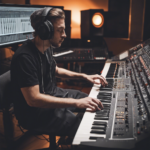
Table of Contents
Music production is a unique blend of creativity and technical skills. Whether you’re a beginner aspiring to create hit songs or an intermediate producer wanting to refine your craft, consistent practice is essential. In this guide, we’ll break down what to practice regularly to master music production and offer some SEO-optimized tips to boost your presence in the online world.
1. Understanding the Basics of Music Productionसंगीत उत्पादन के मूलभूत पहलुओं को समझना
Before diving deep into advanced techniques, mastering the basics is crucial. Here’s what you should focus on:
A. DAW Proficiency
Learn Your DAW: Whether you use Ableton Live, Logic Pro, FL Studio, or Pro Tools, it’s important to explore your Digital Audio Workstation (DAW). Understand its interface, shortcuts, and workflow to speed up your production process.
Experiment with Projects: Create small projects focused on specific elements like drum patterns, chord progressions, or mixing.
B. Music Theory
Scales and Chords: Spend time practicing scales and understanding chord progressions, as they are the backbone of any melody.
Rhythm and Timing: Work with a metronome to develop a better understanding of timing, beats, and tempo.
C. Audio Engineering Basics
Gain Staging: Regularly practice adjusting audio levels to avoid distortion or unwanted clipping.
Signal Flow: Understand how audio flows within your DAW and how it interacts with different effects.
2. Ear Trainingकान की ट्रेनिंग
Developing a good ear is critical to music production. Practice these regularly:
A. Frequency Recognition
Use EQ plugins to isolate different frequencies and identify their roles in a mix.
Practice listening to tracks and identifying bass, mids, and highs.
B. Critical Listening
Dissect professional tracks to understand their arrangement, effects, and mixing techniques.
Focus on how different elements like vocals, drums, and synths are positioned in the mix.
C. Pitch and Harmony
Use ear training apps to identify intervals, chords, and melodies.
Practice harmonizing vocals or instruments by ear, improving your ability to understand music theory in real-time.
3. Sound Designसाउंड डिज़ाइन
Sound design is a defining characteristic of skilled producers. Regular practice should include:
A. Synthesizer Basics
Learn the core principles of synthesis, such as oscillators, filters, envelopes, and LFOs.
Experiment with popular synthesizer plugins like Serum, Massive, or Sylenth1.
B. Sampling Techniques
Practice slicing, layering, and processing different samples.
Create custom drum kits or instrument patches using existing sounds.
C. Effects Processing
Dive into essential effects like reverb, delay, compression, and modulation.
Practice using these effects creatively to add depth and texture to your productions.
4. Composition and Arrangementकंपोज़िशन और अरेंजमेंट
A solid arrangement is crucial for keeping your audience engaged. Focus on the following:
A. Building Song Sections
Practice crafting different parts of a song such as intros, verses, choruses, bridges, and outros.
Analyze popular tracks and learn how they structure their songs.
B. Layering and Dynamics
Layer different sounds to make your productions fuller and more complex.
Practice automating volume, panning, and effects to create dynamic changes in your tracks.
C. Transitions and Builds
Learn to create smooth transitions between sections using risers, sweeps, and drum fills.
Practice building tension and releasing it effectively in your tracks.
5. Mixing and Masteringमिक्सिंग और मास्टरिंग
Polishing your track is just as important as creating it. Regular practice in mixing and mastering will ensure your track stands out:
A. Balancing Levels
Practice balancing various elements in your mix to ensure clarity and coherence.
Use reference tracks to compare your mix against professional standards.
B. EQ and Compression
Practice using EQ to carve out space for each element in your track.
Learn the proper use of compression for dynamic control and punch.
C. Mastering Basics
Work on techniques like limiting, stereo widening, and finalizing your track to make it competitive.
Regularly use metering tools to check your track’s loudness and frequency balance.
6. Staying Updated with Trends and Techniquesनवीनतम ट्रेंड्स और तकनीकों से अपडेट रहें
Music production is ever-changing, and to stay ahead, you need to be constantly learning:
A. Tutorials and Courses
Watch tutorials on platforms like YouTube or take online courses to stay informed about new techniques.
Practice new skills you learn from these videos.
B. Networking with Other Producers
Join forums, attend workshops, and collaborate with other producers to expand your knowledge.
Share your work online and seek feedback from peers.
7. Consistency in Practiceअभ्यास में निरंतरता
Building a habit of regular practice is more important than long, infrequent sessions:
A. Set a Schedule
Dedicate specific times for practicing each area of music production.
For example, 30 minutes for ear training, 1 hour for composition, etc.
B. Track Your Progress
Maintain a journal or digital log of your learning journey.
Regularly revisit old projects to measure your improvement.
8. Experiment and Innovateअन्वेषण और नवाचार
While structured practice is important, don’t forget to experiment and explore your creativity:
A. Genre Exploration
Practice producing in various genres to diversify your skills.
Combine elements from different genres to create unique tracks.
B. Creative Challenges
Challenge yourself by restricting the tools or sounds you can use for a project.
Try remixing songs to understand arrangement and sound design techniques better.
SEO Tips for Promoting Your Music Production Journeyअपने संगीत उत्पादन के सफर को बढ़ावा देने के लिए SEO टिप्स
If you’re documenting your journey or offering services online, SEO can boost your visibility:
1. Keyword Optimization
Use keywords like “learn music production,” “sound design tutorials,” and “music production tips” in your content.
Include these in headings, subheadings, and throughout the article.
2. Engaging Content
Share sample packs, tutorials, and case studies on your blog or website.
Create YouTube videos or Instagram reels showcasing your production process.
3. Backlinking
Collaborate with other producers or bloggers for backlinks.
Submit your work to online communities for greater exposure.
4. Social Media and Forums
Regularly post your work on platforms like Instagram, Pinterest, and SoundCloud.
Participate in discussions on Reddit or music production forums to drive traffic to your website.
Conclusionनिष्कर्षLearning music production is a rewarding journey that blends creativity with technical expertise. By practicing regularly across areas like DAW proficiency, ear training, sound design, and mixing, you can build a strong foundation and improve your skills. Additionally, applying SEO strategies can help you reach a larger audience and gain recognition in the online music community.
Stay consistent with your practice, explore new techniques, and don’t forget to innovate. With dedication, you can transform your passion for music production into a professional skill.


